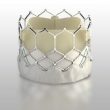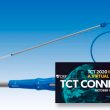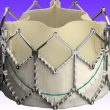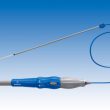The objective of this paper recently published in J Am Coll Cardiol Intv was to compare the outcomes of transcatheter aortic valve replacement (TAVR) with the new Sapien 3 Ultra vs. Sapien 3. Successful implantation was extremely high with both balloon-expandable devices, which also had a very low adverse event rates. However, Sapien Ultra was significantly better<a href="https://solaci.org/en/2020/11/30/balloon-expandable-valve-outdoes-itself/" title="Read more" >...</a>
TCT 2020 | TAVR Appears to Be the Solution for All Dysfunctional Biological Valves
Transcatheter aortic valve replacement (TAVR) results durable at 5 years to treat failed surgical bioprosthetic valves and at one year to treat valves percutaneously. Regardless the type of the failed valve, the solution is TAVR. The 5 year follow up of the PARTNER 2 valve-in-valve (ViV) showed that TAVR as treatment for failed surgical bioprosthetic<a href="https://solaci.org/en/2020/10/21/tct-2020-tavr-appears-to-be-the-solution-for-all-dysfunctional-biological-valves/" title="Read more" >...</a>
TCT 2020 | Acurate Neo Does Not Meet Non-Inferiority vs. CoreValve Evolut
The self-expanding Acurate Neo (Boston Scientific) did not meet non-inferiority vs. the self-expanding CoreValve Evolut (Medtronic) in the SCOPE 2 study published in Circulation simultaneously and presented at the virtual TCT 2020. These are bad news for the Acurate Neo, that had already failed to show non-inferiority vs. the Sapien 3 in the SCOPE 1<a href="https://solaci.org/en/2020/10/21/tct-2020-acurate-neo-does-not-meet-non-inferiority-vs-corevalve-evolut/" title="Read more" >...</a>
Outflow Tract Calcification and the Best Valve in This Context
Moderate or severe left ventricle outflow tract calcification increases the risk of annulus rupture, residual aortic regurgitation and the need for a second valve. This recent study analyzed the performance of different contemporary prosthetic valves in patients with this particular anatomy. Since the early days of transcatheter aortic valve replacement (TAVR) outflow tract calcification has<a href="https://solaci.org/en/2020/09/10/outflow-tract-calcification-and-the-best-valve-in-this-context/" title="Read more" >...</a>
3rd Generation Valves in Large and X-Large Annuli
In patients with large and extra-large annuli, transcatheter aortic valve replacement (TAVR) is safe and feasible with 3rd generation valves: the 29mm balloon expandable valve Sapien-3, and their competitor, the self-expandable 34mm Evolut R. The largest size of both devices was designed specifically for patients with large or extra-large annuli. However, one of them seems<a href="https://solaci.org/en/2020/09/01/3rd-generation-valves-in-large-and-x-large-annuli/" title="Read more" >...</a>
Good Evolution of Bicuspid Valves with EVOLUTE or EVOLUTE PRO
Courtesy of Dr. Carlos Fava. TAVR has matured over time and has advanced onto low risk patients, but one of its greatest challenges continues to be bicuspid valve patients. These represent between 1% and 2% of the population and over 20% of young adults requiring surgical valve replacement (SAVR). The study looked at 27,086 patients<a href="https://solaci.org/en/2020/08/28/good-evolution-of-bicuspid-valves-with-evolute-or-evolute-pro/" title="Read more" >...</a>
Surgical Valve Replacement Might Soon Be History
Patients with dysfunctional biological prosthetic valves have better outcomes with TAVR vs. surgical reintervention, beyond surgical risk. This study outcomes might even call into question the age cutoff to consider a mechanical vs. a biological prosthesis at first surgery. This analysis recently published in JACC looked at the outcomes of both possible strategies to treat<a href="https://solaci.org/en/2020/08/26/surgical-valve-replacement-might-soon-be-history/" title="Read more" >...</a>
Valve in Valve Presents Better Evolution than re-SARV
Courtesy of Dr. Carlos Fava. Surgical aortic valve replacement with bioprosthesis has proved its benefits, but it fails after 10 to 15 years. Transcatheter aortic valve replacement has been shown valid, especially in high risk patients, but we still have little information and no “head to head” studies to know what is best in this<a href="https://solaci.org/en/2020/08/04/valve-in-valve-presents-better-evolution-than-re-sarv/" title="Read more" >...</a>
After 8-year Followup, Good News for the Self Expandable Valve
As the transcatheter aortic valve replacement (TAVR) gains ground in lower risk populations and with better survival rate, concern over its durability has grown. This study brings us data and good news on the first-generation self-expandable valve after quite a long follow up. It included 990 inoperable or high-risk patients treated with CoreValve in 8<a href="https://solaci.org/en/2020/07/22/after-8-year-followup-good-news-for-the-self-expandable-valve/" title="Read more" >...</a>
EuroPCR 2020 | Aortic Valve in Valve in the Long Term
The outcomes of this work are important to plan valve replacement with the largest possible prosthesis allowed by patient anatomy in the index procedure. As a worldwide trend, increasingly more patients are receiving bioprostheses, which have improved a lot but still tend to become deteriorated and require a valve-in-valve procedure if the patient is no<a href="https://solaci.org/en/2020/07/13/europcr-2020-aortic-valve-in-valve-in-the-long-term/" title="Read more" >...</a>









